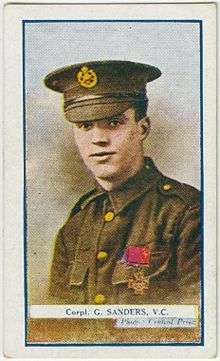George Sanders (VC)
| George Sanders | |
|---|---|
 | |
| Born |
8 July 1894 Leeds, West Yorkshire, England |
| Died |
4 April 1950 (aged 55) Leeds, West Yorkshire, England |
| Allegiance |
|
| Service/branch |
|
| Years of service | 1914-1919 |
| Rank | Captain |
| Unit | West Yorkshire Regiment |
| Battles/wars | World War I |
| Awards | |
George Sanders VC MC (8 July 1894 – 4 April 1950) was an English recipient of the Victoria Cross, the highest and most prestigious award for gallantry in the face of the enemy that can be awarded to British and Commonwealth forces.
Early life
George Sanders was the son of Thomas and Amy Sanders. He received his education at Little Holbeck School and after completing his time there was indentured as an apprentice fitter at the nearby Airedale Foundry.
Military service
George enlisted for service on 9 November 1914 and was drafted as a corporal to the 1/7th (Leeds Rifles) Battalion, West Yorkshire Regiment (The Prince of Wales's Own), British Army during the First World War when the following deed took place for which he was awarded the VC.[1]
The VC action
On 1 July 1916 near Thiepval, France, during the Battle of the Somme, after an advance into the enemy's trenches, Corporal Sanders found himself isolated with a party of 30 men. He organised his defences, detailed a bombing party, and impressed upon the men that his and their duty was to hold the position at all costs. Next morning he drove off an attack by the enemy, rescuing some prisoners who had fallen into their hands. Later two bombing attacks were driven off, and he was finally relieved after 36 hours. All this time his party had been without food and water, having given their water to the wounded during the first night.[2]
After receiving his Victoria Cross on 18 November 1916 at Buckingham Palace, from the King, he returned to the front.
In April 1918 the German Army launched the Spring Offensive. Sanders unit, the West Yorks, were at Mount Kemmel. Heavy fighting ensued and acting Captain Sanders was awarded the Military Cross. He was taken prisoner of war (POW) on 25 April and listed as wounded and missing with injuries to both his right arm and leg, last seen carrying his revolver in his left hand. Sanders was interned at the Limburg POW camp. In July he managed to get a letter to his father telling of his capture and captivity. On 26 December Captain Sanders was sent back to England, and he was discharged in March 1919.
Later life
After the war in June 1920 he attended a victory party and a Victory Cross reunion dinner on the tenth anniversary of the end of the war in November 1929, both at Buckingham Palace.
Sanders unveiled the Leeds Rifles War Memorial at Leeds Minster on Remembrance Sunday 1921.[3]
George Sanders VC MC died in Leeds on 4 April 1950 aged 56. His funeral was held at the Cottingley Crematorium in the city.
The Medal
His VC is held in a private collection.
References
- ↑ HELLFIRE CORNER - Nine VCs of the First day on the Somme
- ↑ The London Gazette: (Supplement) no. 29740. p. 8870. 9 September 1916. Retrieved 8 November 2009.
- ↑ Historic England. "North Boundary Wall and Steps, North West Gate and Piers, War Memorial and East Bar Stone (1375049)". National Heritage List for England. Retrieved 21 August 2016.
External links
- Location of grave and VC medal (West Yorkshire)
- The Nine VCs of the First Day on the Somme
- Monuments to Courage (David Harvey, 1999)
- The Register of the Victoria Cross (This England, 1997)
- VCs of the First World War - The Somme (Gerald Gliddon, 1994)